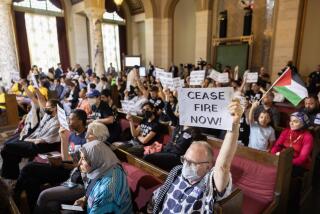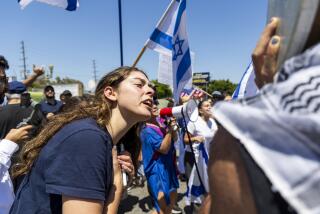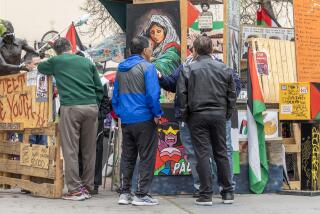Thousands Join March Against L.A. Violence : Crime: About 4,000 cheer, sing and pray for an end to gangs, graffiti, drugs, violence.
Thousands of people marched around Exposition Park on Saturday in what authorities said was the largest anti-crime demonstration in Los Angeles history, but few felt the urgency that moved Jesse Martinez.
A member of Carpenter’s Local 309 and an organizer of the rally, Martinez was awakened late one night last week by the sound of gunfire outside his East Los Angeles home. Stepping out in the darkness, he found a young man, fatally shot, lying face down in the street.
“I knelt down and rolled him over on my thigh,” said Martinez, 47. “I didn’t know him, but it was so creepy. He was bleeding and barely breathing. That really brought this all home for me.”
Energized by his experience, Martinez and thousands of others cheered, sang and prayed in an unprecedented call for an end to gangs, graffiti, drugs and violence. Police estimated the crowd at about 4,000, while sponsors of the march said more than twice that number participated.
“This is the first time I’ve seen a demonstration like this,” Lou Huett, a Los Angeles mounted police officer, said from atop his horse.
The event, dubbed “Turn the Tide,” drew celebrities, Guardian Angels, nuns, students, community leaders and more than a dozen politicians and candidates.
Together they marched the two-mile perimeter of the park, wearing T-shirts that said, “Made the March, Made a Difference,” waving signs that read, “There Is No Problem That Love Can’t Solve,” and chanting, “Too many mothers are crying, too many sons are dying. . . . Once you die, you can never come back. Stop using those guns, stop using that crack.”
“This could really help a lot of people,” said Noe Salgado Morelos, 26, who was pushing his cart of fruit-flavored paletas along Exposition Boulevard. “I’m not even worried about selling. I’m just watching what’s going on.”
At a rally beforehand, Mayor Tom Bradley pledged an extra $1 million in next year’s budget to help fight graffiti in the city. Dist. Atty. Ira Reiner, a Democratic candidate for attorney general, vowed to support a seven-point agenda aimed at battling crime and then meet with activists in 60 days to discuss his progress. Reiner’s rival, San Francisco Dist. Atty. Arlo Smith, also spoke, as did Archbishop Roger M. Mahony, who compared the event to the parting of the Red Sea. And actor Edward James Olmos, who delivered the keynote address, blamed the gang problem on a greed-driven society that has lost touch with its values.
“We’re here to say, ‘Enough is enough,’ ” City Councilman Zev Yaroslavsky said. “More people die in this city as a result of gang violence every year than die in Beirut, Lebanon. And no one wants to go to Beirut.”
Gang-related murders were up 23% in the county last year, from 452 homicides in 1988 to 554 in 1989. During the last 10 years, the county’s gang population has surged from 25,000 to about 80,000.
The bulk of the crowd came from the ranks of four church-based community groups--UNO, SCOC, EVO and VOICE--that for years have been winning local political battles by practicing the credo of the late Chicago social reformer Saul Alinsky, who believed that organized people can beat organized money.
Spelled out, they are United Neighborhoods Organization, based in East Los Angeles; Southern California Organizing Committee, which covers South-Central Los Angeles; East Valleys Organization, which represents the San Gabriel and Pomona valleys, and Valley Organized in Community Efforts, the San Fernando Valley’s link.
Their unique alliance claims a constituency of nearly 250,000 families throughout the county, the vast majority of whom are either low-income blacks or Latinos with ties to Catholic or Protestant churches.
But because of a mainstream media blitz--sponsored by KABC Talkradio, KABC television, Vons Grocery Stores and Main Street Dairy--organizers had predicted that some of the city’s more affluent enclaves would also be represented.
It was difficult to determine whether the event had drawn marchers from communities as diverse as Westwood and Watts, Pacific Palisades and Pacoima. But leaders were satisfied.
“I think we can say that this has been historic,” said Tony Massengale, a South-Central Los Angeles activist. “It was truly multi-ethnic and multi-denominational. All four corners of the county were represented. For this issue, nothing like this has ever happened before.”
Nonetheless, organizers say Saturday’s demonstration was only the first step in an uphill battle to regain control of their neighborhoods.
As the marchers passed along Menlo Avenue, two young women sitting on the stoop of the Exposition Recreation Center showed why. They pointed to several of the marchers who belonged to the Los Angeles Conservation Corps and were wearing sweat shirts that read “Clean & Green.”
“This neighborhood ain’t clean and green,” 17-year-old Sharese Williams said.
“That’s right,” said Mandy Sibrie, 19. “It’s rough and tough and dirty.”
More to Read
Sign up for Essential California
The most important California stories and recommendations in your inbox every morning.
You may occasionally receive promotional content from the Los Angeles Times.










